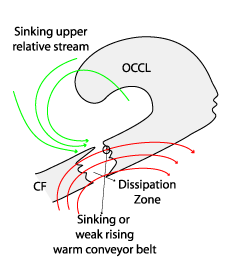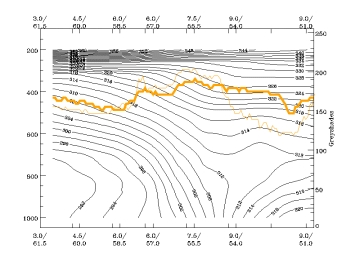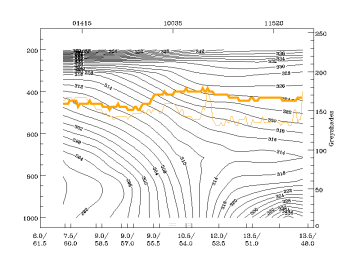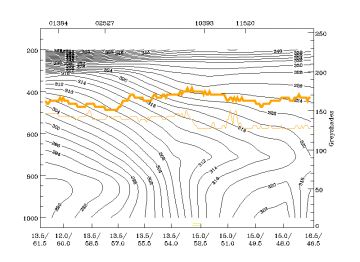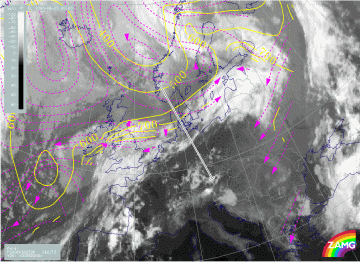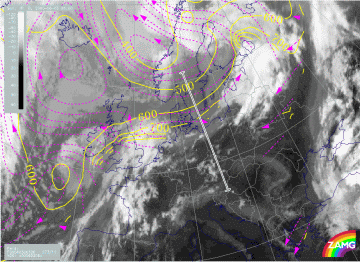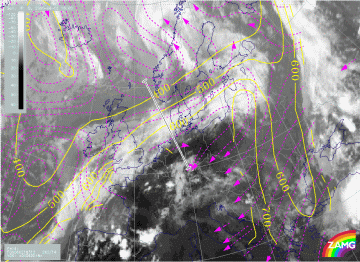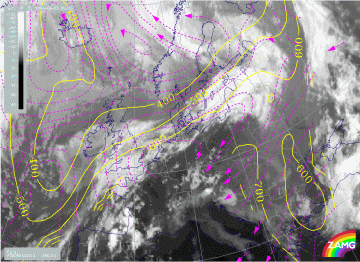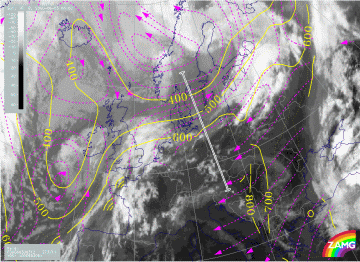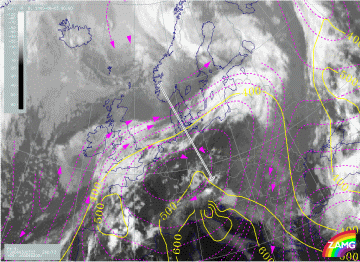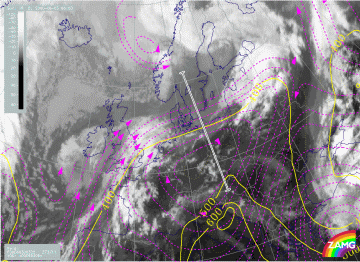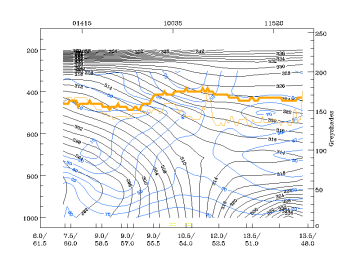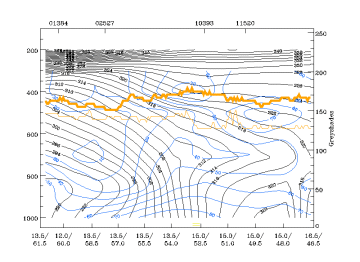Physical Background enlightened with help of relative streams
The physics of a Front Decay is well described using relative streams (see Conceptual Models: Front Decay - Meteorological physical background ). One of the three typical configurations show the involvement of air rotating around the centre of the main low attached to the frontal system. A sinking upper relative stream from the rear (upper relative stream and/or dry intrusion) develops, which flows at nearly right angles to the frontal cloud band at low and middle levels, leading to the characteristic dissipation of cloudiness. At upper levels, a sinking or only very weakly rising Warm Conveyor Belt can be observed.
|
|
|
In order to more easily identify of the frontal surfaces and the selection of appropriate indicative isentropic surfaces, vertical cross sections are presented below (for exact location of isentropic surfaces see satellite images below).
|
02 June 2000/18.00 UTC - Vertical cross section; black: isentropes (ThetaE), orange thin: IR pixel values, orange thick: WV pixel values
|
03 June 2000/00.00 UTC - Vertical cross section; black: isentropes (ThetaE), orange thin: IR pixel values, orange thick: WV pixel values
|
|
03 June 2000/06.00 UTC - Vertical cross section; black: isentropes (ThetaE), orange thin: IR pixel values, orange thick: WV pixel values
|
|
The above vertical cross sections cover the area of the dissipation zone at three consecutive times. To the left of all 3 cross sections the frontal gradient zone of a CF can be seen, which remains more or less constant over the 12 hours of observation. On the basis of the information presented the following isentropic surfaces for relative streams are chosen:
Relative streams at low levels
306K is an isentropic surface which represents low levels within the front. The air mass involved with the dry intrusion originates near the
centre of the main low. At 02/18.00 UTC a relative stream from behind the front crosses the cloud band at nearly right angles and descends from
550 hPa down to 800 hPa. At 03/00.00 UTC, the angle between the dry intrusion and the frontal cloud band becomes more acute. Air is still
sinking from 500 hPa to about 850 hPa. The descent indicated by the relative streams has reached its lowest level. At 03/12.00 UTC the cloud
dissipation has reached a mature stage. The Wave upstream, over Great Britain and the North Sea, has developed into a new system with Cold
Front and Warm Front, and a relative stream associated with the Warm Front is now dominant. The dry intrusion relative stream has moved to the
rear side of the frontal cloud band and has no more relevance for the mechanism of Front Decay.
The observed relative flow pattern at low levels support the physical concept of Front Decay very well.
|
02 June 2000/18.00 UTC - Meteosat IR image; magenta: relative streams 306K - system velocity: 262° 14 m/s, yellow: isobars,
position of vertical cross section indicated
|
03 June 2000/00.00 UTC - Meteosat IR image; magenta: relative streams 306K - system velocity: 260° 13 m/s, yellow: isobars,
position of vertical cross section indicated
|
|
03 June 2000/06.00 UTC - Meteosat IR image; magenta: relative streams 306K - system velocity: 273° 11 m/s, yellow: isobars,
position of vertical cross section indicated
|
|
Relative streams at middle levels
By 18.00 UTC on the 02 June 2000, the isentropic surface of 312K shows a distinctly sinking upper relative stream. The relative stream related
to the main low, and responsible for cloud dissipation at lower levels is now situated more to the rear of the frontal cloud band. To the south
of the front band the relative streams indicate a sinking Warm Conveyor Belt over Denmark.
At 03/00.00 UTC both the upper relative stream and the Warm Conveyor Belt are becoming more pronounced, downward motion from 450 hPa to 650 hPa
over the dissolution zone of the Front Decay. At 06.00 UTC the Warm Conveyor Belt is dominating the whole frontal cloud band and reaches far
behind the front.
The Warm Conveyor Belt is rising over the area of the Warm Front over Great Britain and the North Sea, as well as over the area of the Cold
Front in Warm Advection over the Baltic Sea and the Baltic States. However, the relative stream over the dissipation zone still shows downward
motion.
|
02 June 2000/18.00 UTC - Meteosat IR image; magenta: relative streams 312K - system velocity: 262° 14 m/s, yellow: isobars,
position of vertical cross section indicated
|
03 June 2000/00.00 UTC - Meteosat IR image; magenta: relative streams 312K - system velocity: 260° 13 m/s, yellow: isobars,
position of vertical cross section indicated
|
|
03 June 2000/06.00 UTC - Meteosat IR image; magenta: relative streams 312K - system velocity: 273° 11 m/s, yellow: isobars,
position of vertical cross section indicated
|
|
Relative streams at high levels
A very weak sinking Warm Conveyor Belt dominates the front at 18.00 UTC.
The sinking motion becomes more intense by 03/00.00 UTC associated with the dissipation of the frontal cloud band. At this time, a sinking Warm Conveyor Belt seems to be the driving force for the complete dissolution of the frontal clouds.
At 03/12.00 UTC, the sinking motion over Northern Europe and the Baltic Sea is still well shown by the relative streams of the isentropic
surface of 322K.
|
02 June 2000/18.00 UTC - Meteosat IR image; magenta: relative streams 322K - system velocity: 262° 14 m/s, yellow: isobars,
position of vertical cross section indicated
|
03 June 2000/00.00 UTC - Meteosat IR image; magenta: relative streams 322K - system velocity: 260° 13 m/s, yellow: isobars,
position of vertical cross section indicated
|
|
03 June 2000/06.00 UTC - Meteosat IR image; magenta: relative streams 322K - system velocity: 273° 11 m/s, yellow: isobars,
position of vertical cross section indicated
|
|
The distribution of relative streams at various levels demonstrates well the physical processe behind the significant dissipation of cloud dissolution observed in the satellite image loops. Furthermore, the case of 02/03 June 2000 is a good example of Front Decay; especially for that type of Front Decay where air masses at low and middle levels originate from near the centre of the main low.
The drying process causing the cloud dissipation can be related to the sinking upper relative streams to the rear of the frontal cloud band.
This is well seen in the vertical cross section of relative humidity:
A dry maximum, with 20% relative humidity on 02/18.00 UTC, is positioned to the rear of the frontal cloud band and extends at higher levels
during the next 12 hours over the complete frontal gradient zone; This can be associated with lower IR and WV pixel values. This mechanism
coincides with the observed reduction in cloudiness at higher levels during the initial stages of Front Decay.
|
02 June 2000/18.00 UTC - Vertical cross section; black: isentropes (ThetaE), blue: relative humidity, orange thin: IR pixel values,
orange thick: WV pixel values
|
03 June 2000/00.00 UTC - Vertical cross section; black: isentropes (ThetaE), blue: relative humidity, orange thin: IR pixel values,
orange thick: WV pixel values
|
|
03 June 2000/06.00 UTC - Vertical cross section; black: isentropes (ThetaE), blue: relative humidity, orange thin: IR pixel values,
orange thick: WV pixel values
|
|
